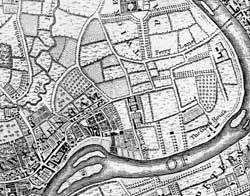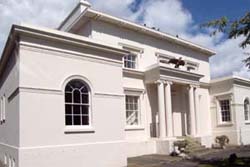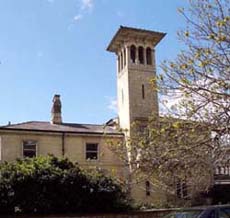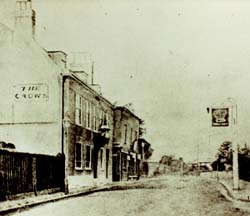Richmond Road
The highway to Richmond Ferry
1443

An ancient track led from Church Street, then the centre of Twickenham village, up to the north bank of the Thames, where there was a ferry to Richmond first recorded in 1443 and capable of carrying beasts and vehicles. In the 17th century there was little or no housing in this part of the parish save the Countess of Totnes’ house (where Cambridge Park used to stand). The track crossed the Great East Field, then “open”, with its “shots“, riverside pastures, a rabbit warren and passed along the boundary of Twickenham Park. The track had no name but was referred to in the Syon Manor records, in dog Latin, as “alta via ducen ad Richmond Ferry” (the high way leading to Richmond Ferry). By the 18th century the stretch nearest the Ferry had acquired the name ”Ferry Lane”.
18th century developments
There were some changes during the 18th century. A new house, later known as Orleans house was erected in 1710. Close to its large grounds there was the Crown Inn, whose landlord at one time acted as a postmaster. A row of houses, known as Montpelier Row, and a chapel, was erected in the early 1720s. Shortly after, Marble Hill was built and its grounds enclosed. Down by the river there had been a “Glass House”, but this disappeared in about 1750 and the site was taken over by Little Marble Hill (also known as Marble Hill Cottage). At the bend in the track, opposite where St Stephen’s church now stands, there was, in 1786, a brick yard.Thomas Stonor took a lease on South End House in Montpelier Row in 1733. He was not satisfied with the state of the road and the Vestry minutes for 22 August 1736 record that "Whereas an indictm't hath been preferred by Thomas Stonor Esquire & is now depending ag[ains]t the Inhabitants of this parish for not repairing & amending a certain lane "leading from the Crown Inn near Montpellier Row to Mrs Vernon's Park Gate lying next to Isleworth it is apprehended that this parish is not liable to repair" There was no further record of the complaint. Mrs Vernon, Thomas Vernon's widow, was then living at Twickenham Park.
Construction of Richmond Bridge
The construction of a toll bridge, linking the Middlesex and Surrey banks of the Thames foreshadowed a period of great change. After the bridge was opened in 1777, the practice grew of calling the road leading to it “Richmond Road”. Traffic along this road increased, leading to the need for widening. On 7 November 1837 James Gooch, the Vestry Clerk wrote to the Metropolitan Commissioners of Roads asking if they would take the road under their management as a public Turnpike. Gooch had already written, on 6 November to Alexander Murray, the owner of Orleans House, seeking to buy a five foot strip of ground between his lodge and "Miss Byng's Ground". A further letter to an unknown owner, possibly Miss Byng herself, at Mount Lebanon, was sent on 13 November asking for a six foot strip of land to be released. Owners were invited to state their price.

19th century developments
The early 19th century brought with it not only Enclosure, but a growth in population. Near the bridge, houses appeared on the north side of the road. Modest villas such as Ryde House and Willoughby House (both still standing) were erected in the first decades. Later, with the gradual break-up of the Twickenham Park estate more houses were built, particularly after the 1850s.The process continuing well into the 20th century, covering the whole of former Twickenham Park.

Similar development took place over the area previously covered by Cambridge Park. At first the break up of the estate was gradual and largely affected land bordering on the Thames with the establishment of a few large houses set in extensive grounds. The pace quickened in the 1860s leading eventually to the creation of the modern Cambridge Park. The establishment of a new parish served by the St Stephen's church, consecrated in December 1875 (its tower was not added until 1907), marked the arrival of a new suburb. Shops to serve the growing community sprang up along Richmond Road from near the bridge to just beyond the junction with St Margaret's Road.
Closer to central Twickenham such land as was not already tied up with the great houses (e g Marble Hill House, Orleans House, Lebanon House, York House, and Arragon House) was available for building houses as the population increased but the process was more gradual since much of the area was then given over to nursery land and market gardening.
An example of the conversion of land from agriculture to housing occurred In 1840,when a row of houses at first called "Crown Crescent", was built almost opposite the Crown Inn.
Over the centuries, Richmond Road has seen many changes. Once the rural scene of slow moving carts and coaches - and the occasional highwayman - it is now a busy urban thoroughfare, too often clogged with slow moving motor vehicles, its course marked by traffic lights, pedestrian crossings, a mini-roundabout and outbreaks of road rage.





